Recognition of Prior Learning (RPL) Self-Evaluation HLT33115
VerifiedAdded on 2023/04/21
|29
|7373
|136
Homework Assignment
AI Summary
This document is a self-evaluation tool designed for students pursuing the HLT33115 Certificate III in Health Services Assistance, specifically those seeking Recognition of Prior Learning (RPL). The document is structured around key skill sets, including Work Health and Safety (WHS) and infection control, communication and personal development, client services, and acute care. Each section presents a series of questions and prompts the student to provide evidence of their skills and knowledge through yes/no responses and detailed explanations. The evaluation covers topics such as workplace safety procedures, hazard identification, communication with diverse populations, client care, and adherence to legal and ethical standards. The student is encouraged to reflect on their experiences and provide specific examples to demonstrate their competence in each area. The document aims to provide a comprehensive assessment of the student's existing skills and knowledge, allowing them to gain recognition for their prior learning and potentially accelerate their progress in the program.
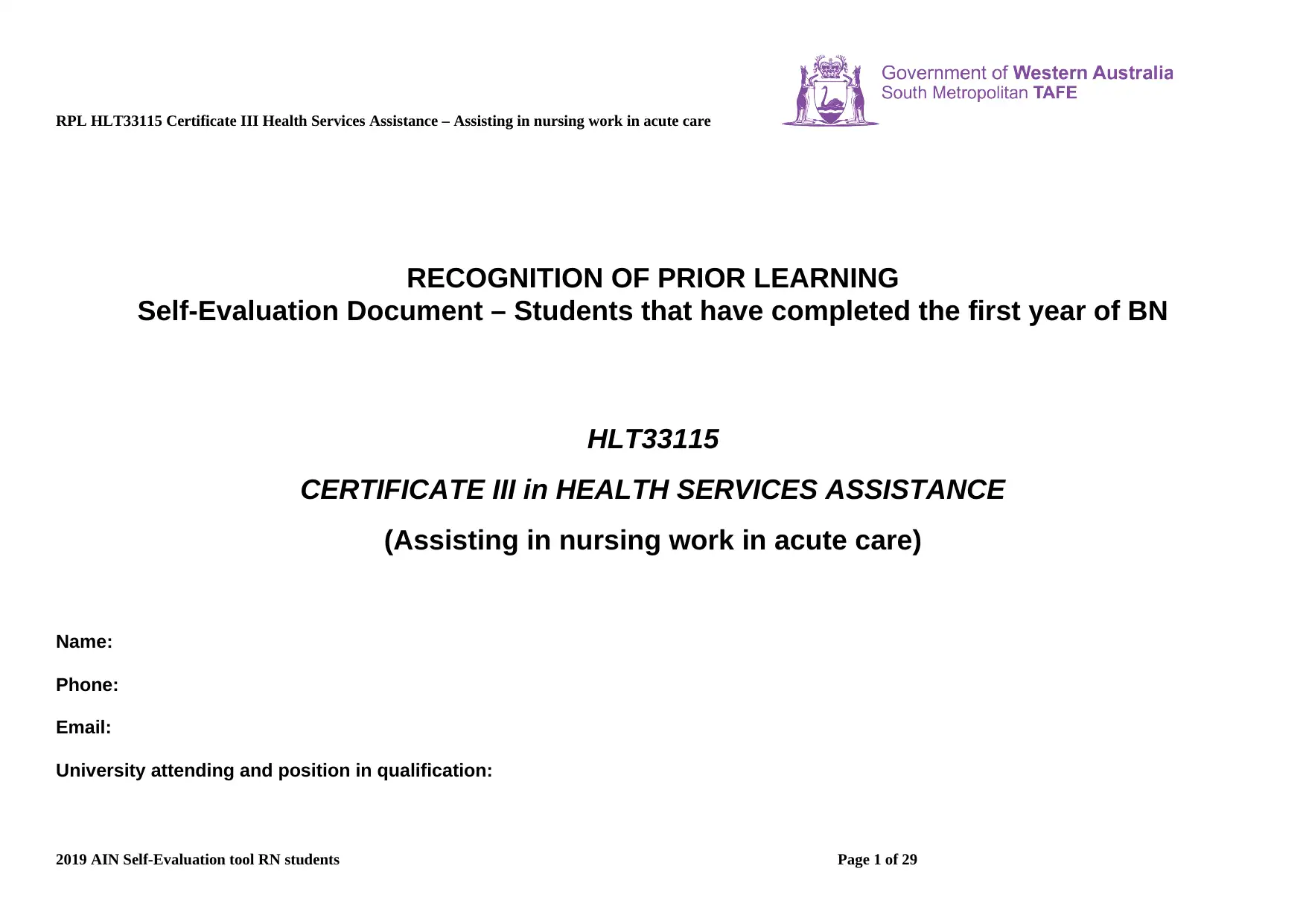
RPL HLT33115 Certificate III Health Services Assistance – Assisting in nursing work in acute care
RECOGNITION OF PRIOR LEARNING
Self-Evaluation Document – Students that have completed the first year of BN
HLT33115
CERTIFICATE III in HEALTH SERVICES ASSISTANCE
(Assisting in nursing work in acute care)
Name:
Phone:
Email:
University attending and position in qualification:
2019 AIN Self-Evaluation tool RN students Page 1 of 29
RECOGNITION OF PRIOR LEARNING
Self-Evaluation Document – Students that have completed the first year of BN
HLT33115
CERTIFICATE III in HEALTH SERVICES ASSISTANCE
(Assisting in nursing work in acute care)
Name:
Phone:
Email:
University attending and position in qualification:
2019 AIN Self-Evaluation tool RN students Page 1 of 29
Paraphrase This Document
Need a fresh take? Get an instant paraphrase of this document with our AI Paraphraser
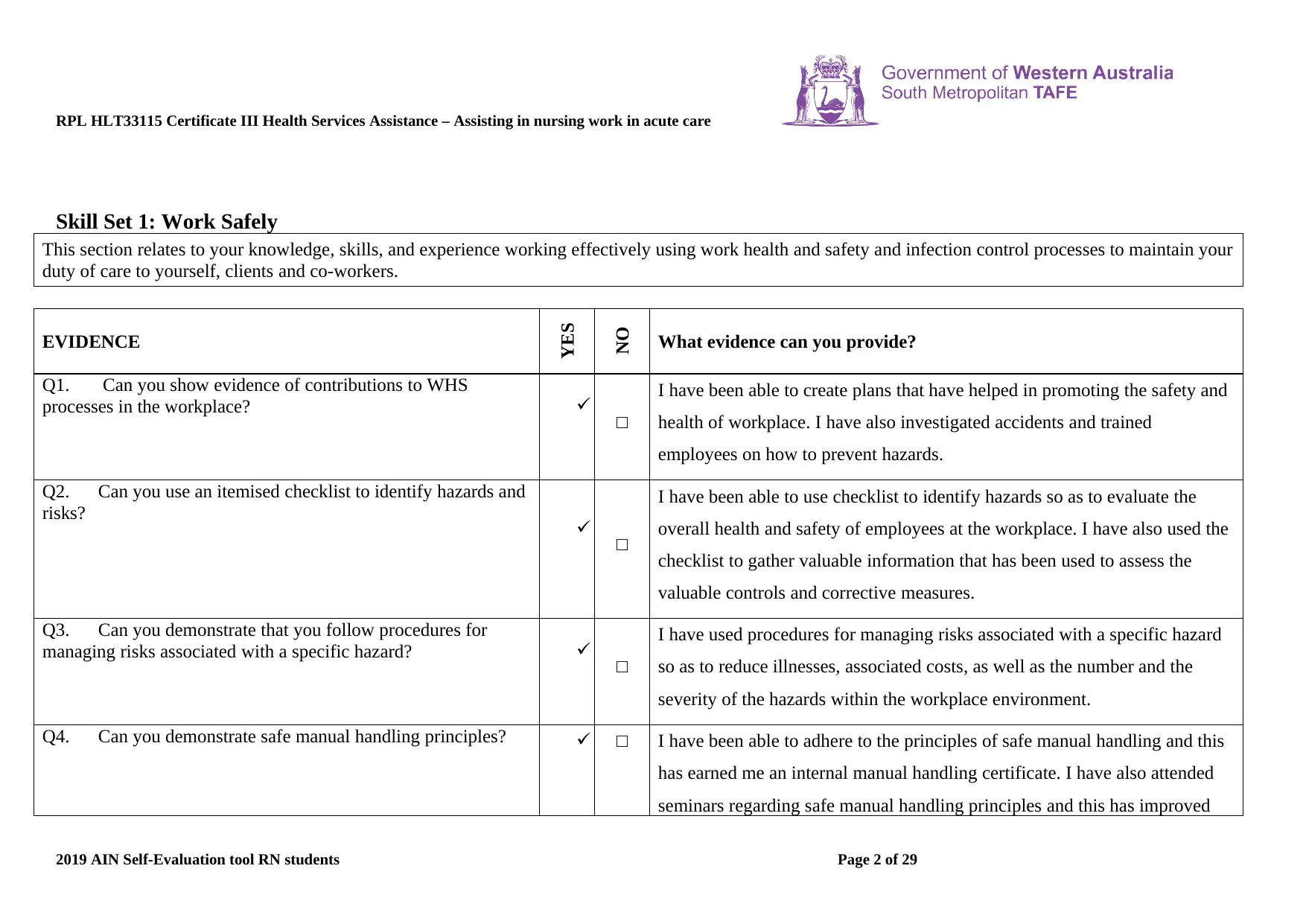
RPL HLT33115 Certificate III Health Services Assistance – Assisting in nursing work in acute care
Skill Set 1: Work Safely
This section relates to your knowledge, skills, and experience working effectively using work health and safety and infection control processes to maintain your
duty of care to yourself, clients and co-workers.
EVIDENCE
YES
NO
What evidence can you provide?
Q1. Can you show evidence of contributions to WHS
processes in the workplace? □
I have been able to create plans that have helped in promoting the safety and
health of workplace. I have also investigated accidents and trained
employees on how to prevent hazards.
Q2. Can you use an itemised checklist to identify hazards and
risks? □
I have been able to use checklist to identify hazards so as to evaluate the
overall health and safety of employees at the workplace. I have also used the
checklist to gather valuable information that has been used to assess the
valuable controls and corrective measures.
Q3. Can you demonstrate that you follow procedures for
managing risks associated with a specific hazard? □
I have used procedures for managing risks associated with a specific hazard
so as to reduce illnesses, associated costs, as well as the number and the
severity of the hazards within the workplace environment.
Q4. Can you demonstrate safe manual handling principles? □ I have been able to adhere to the principles of safe manual handling and this
has earned me an internal manual handling certificate. I have also attended
seminars regarding safe manual handling principles and this has improved
2019 AIN Self-Evaluation tool RN students Page 2 of 29
Skill Set 1: Work Safely
This section relates to your knowledge, skills, and experience working effectively using work health and safety and infection control processes to maintain your
duty of care to yourself, clients and co-workers.
EVIDENCE
YES
NO
What evidence can you provide?
Q1. Can you show evidence of contributions to WHS
processes in the workplace? □
I have been able to create plans that have helped in promoting the safety and
health of workplace. I have also investigated accidents and trained
employees on how to prevent hazards.
Q2. Can you use an itemised checklist to identify hazards and
risks? □
I have been able to use checklist to identify hazards so as to evaluate the
overall health and safety of employees at the workplace. I have also used the
checklist to gather valuable information that has been used to assess the
valuable controls and corrective measures.
Q3. Can you demonstrate that you follow procedures for
managing risks associated with a specific hazard? □
I have used procedures for managing risks associated with a specific hazard
so as to reduce illnesses, associated costs, as well as the number and the
severity of the hazards within the workplace environment.
Q4. Can you demonstrate safe manual handling principles? □ I have been able to adhere to the principles of safe manual handling and this
has earned me an internal manual handling certificate. I have also attended
seminars regarding safe manual handling principles and this has improved
2019 AIN Self-Evaluation tool RN students Page 2 of 29
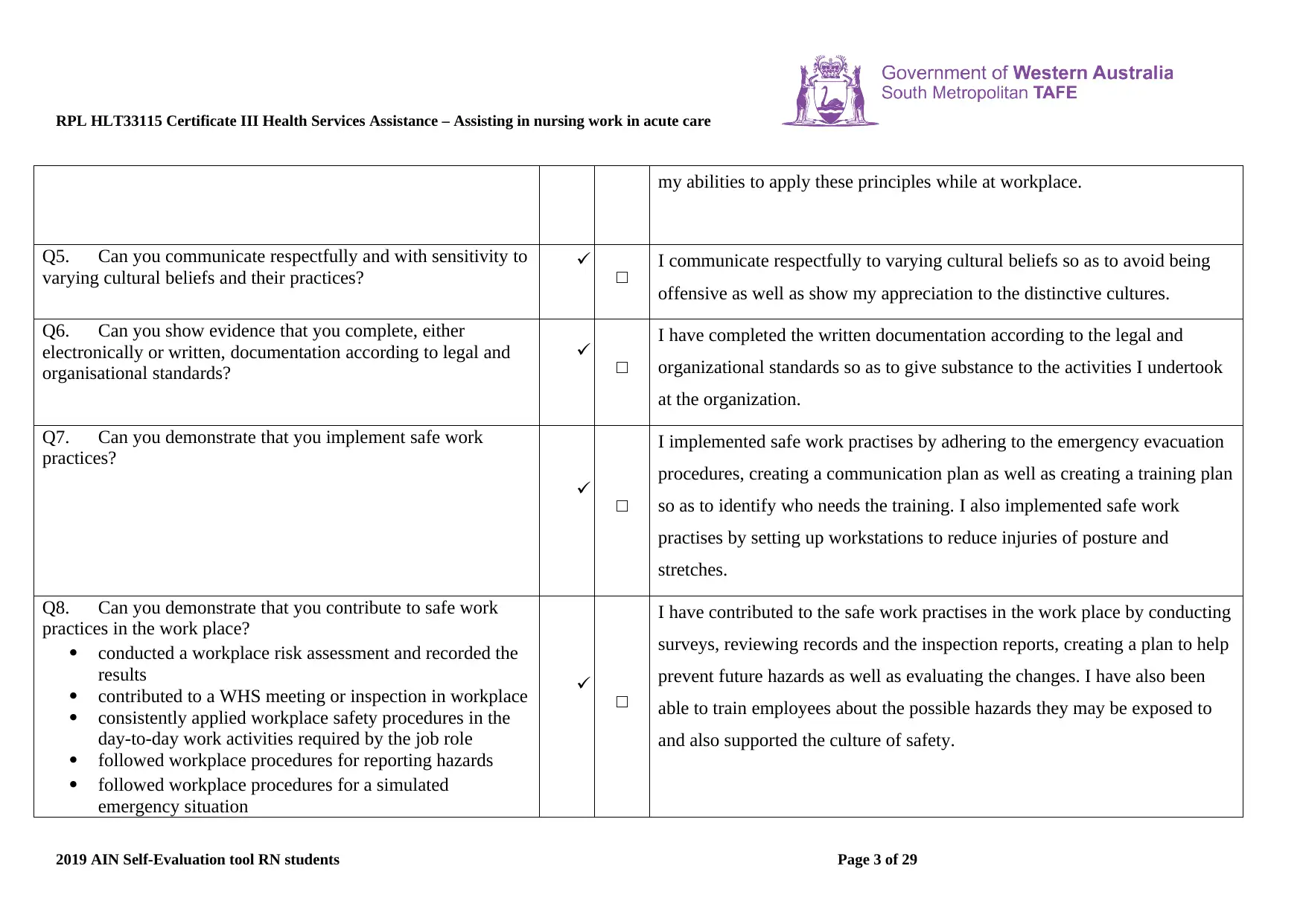
RPL HLT33115 Certificate III Health Services Assistance – Assisting in nursing work in acute care
my abilities to apply these principles while at workplace.
Q5. Can you communicate respectfully and with sensitivity to
varying cultural beliefs and their practices? □ I communicate respectfully to varying cultural beliefs so as to avoid being
offensive as well as show my appreciation to the distinctive cultures.
Q6. Can you show evidence that you complete, either
electronically or written, documentation according to legal and
organisational standards?
□
I have completed the written documentation according to the legal and
organizational standards so as to give substance to the activities I undertook
at the organization.
Q7. Can you demonstrate that you implement safe work
practices?
□
I implemented safe work practises by adhering to the emergency evacuation
procedures, creating a communication plan as well as creating a training plan
so as to identify who needs the training. I also implemented safe work
practises by setting up workstations to reduce injuries of posture and
stretches.
Q8. Can you demonstrate that you contribute to safe work
practices in the work place?
conducted a workplace risk assessment and recorded the
results
contributed to a WHS meeting or inspection in workplace
consistently applied workplace safety procedures in the
day-to-day work activities required by the job role
followed workplace procedures for reporting hazards
followed workplace procedures for a simulated
emergency situation
□
I have contributed to the safe work practises in the work place by conducting
surveys, reviewing records and the inspection reports, creating a plan to help
prevent future hazards as well as evaluating the changes. I have also been
able to train employees about the possible hazards they may be exposed to
and also supported the culture of safety.
2019 AIN Self-Evaluation tool RN students Page 3 of 29
my abilities to apply these principles while at workplace.
Q5. Can you communicate respectfully and with sensitivity to
varying cultural beliefs and their practices? □ I communicate respectfully to varying cultural beliefs so as to avoid being
offensive as well as show my appreciation to the distinctive cultures.
Q6. Can you show evidence that you complete, either
electronically or written, documentation according to legal and
organisational standards?
□
I have completed the written documentation according to the legal and
organizational standards so as to give substance to the activities I undertook
at the organization.
Q7. Can you demonstrate that you implement safe work
practices?
□
I implemented safe work practises by adhering to the emergency evacuation
procedures, creating a communication plan as well as creating a training plan
so as to identify who needs the training. I also implemented safe work
practises by setting up workstations to reduce injuries of posture and
stretches.
Q8. Can you demonstrate that you contribute to safe work
practices in the work place?
conducted a workplace risk assessment and recorded the
results
contributed to a WHS meeting or inspection in workplace
consistently applied workplace safety procedures in the
day-to-day work activities required by the job role
followed workplace procedures for reporting hazards
followed workplace procedures for a simulated
emergency situation
□
I have contributed to the safe work practises in the work place by conducting
surveys, reviewing records and the inspection reports, creating a plan to help
prevent future hazards as well as evaluating the changes. I have also been
able to train employees about the possible hazards they may be exposed to
and also supported the culture of safety.
2019 AIN Self-Evaluation tool RN students Page 3 of 29
⊘ This is a preview!⊘
Do you want full access?
Subscribe today to unlock all pages.

Trusted by 1+ million students worldwide
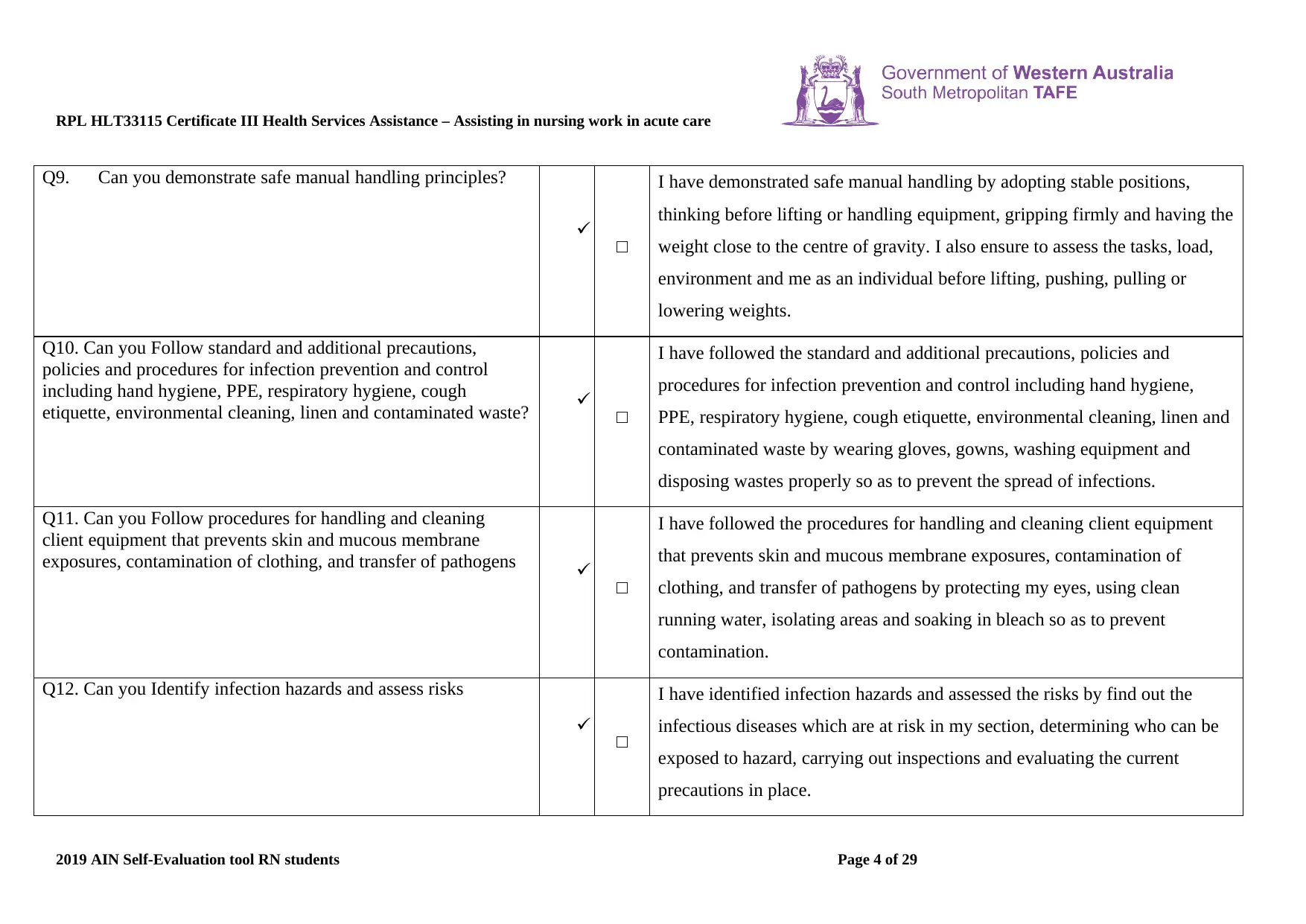
RPL HLT33115 Certificate III Health Services Assistance – Assisting in nursing work in acute care
Q9. Can you demonstrate safe manual handling principles?
□
I have demonstrated safe manual handling by adopting stable positions,
thinking before lifting or handling equipment, gripping firmly and having the
weight close to the centre of gravity. I also ensure to assess the tasks, load,
environment and me as an individual before lifting, pushing, pulling or
lowering weights.
Q10. Can you Follow standard and additional precautions,
policies and procedures for infection prevention and control
including hand hygiene, PPE, respiratory hygiene, cough
etiquette, environmental cleaning, linen and contaminated waste? □
I have followed the standard and additional precautions, policies and
procedures for infection prevention and control including hand hygiene,
PPE, respiratory hygiene, cough etiquette, environmental cleaning, linen and
contaminated waste by wearing gloves, gowns, washing equipment and
disposing wastes properly so as to prevent the spread of infections.
Q11. Can you Follow procedures for handling and cleaning
client equipment that prevents skin and mucous membrane
exposures, contamination of clothing, and transfer of pathogens □
I have followed the procedures for handling and cleaning client equipment
that prevents skin and mucous membrane exposures, contamination of
clothing, and transfer of pathogens by protecting my eyes, using clean
running water, isolating areas and soaking in bleach so as to prevent
contamination.
Q12. Can you Identify infection hazards and assess risks
□
I have identified infection hazards and assessed the risks by find out the
infectious diseases which are at risk in my section, determining who can be
exposed to hazard, carrying out inspections and evaluating the current
precautions in place.
2019 AIN Self-Evaluation tool RN students Page 4 of 29
Q9. Can you demonstrate safe manual handling principles?
□
I have demonstrated safe manual handling by adopting stable positions,
thinking before lifting or handling equipment, gripping firmly and having the
weight close to the centre of gravity. I also ensure to assess the tasks, load,
environment and me as an individual before lifting, pushing, pulling or
lowering weights.
Q10. Can you Follow standard and additional precautions,
policies and procedures for infection prevention and control
including hand hygiene, PPE, respiratory hygiene, cough
etiquette, environmental cleaning, linen and contaminated waste? □
I have followed the standard and additional precautions, policies and
procedures for infection prevention and control including hand hygiene,
PPE, respiratory hygiene, cough etiquette, environmental cleaning, linen and
contaminated waste by wearing gloves, gowns, washing equipment and
disposing wastes properly so as to prevent the spread of infections.
Q11. Can you Follow procedures for handling and cleaning
client equipment that prevents skin and mucous membrane
exposures, contamination of clothing, and transfer of pathogens □
I have followed the procedures for handling and cleaning client equipment
that prevents skin and mucous membrane exposures, contamination of
clothing, and transfer of pathogens by protecting my eyes, using clean
running water, isolating areas and soaking in bleach so as to prevent
contamination.
Q12. Can you Identify infection hazards and assess risks
□
I have identified infection hazards and assessed the risks by find out the
infectious diseases which are at risk in my section, determining who can be
exposed to hazard, carrying out inspections and evaluating the current
precautions in place.
2019 AIN Self-Evaluation tool RN students Page 4 of 29
Paraphrase This Document
Need a fresh take? Get an instant paraphrase of this document with our AI Paraphraser
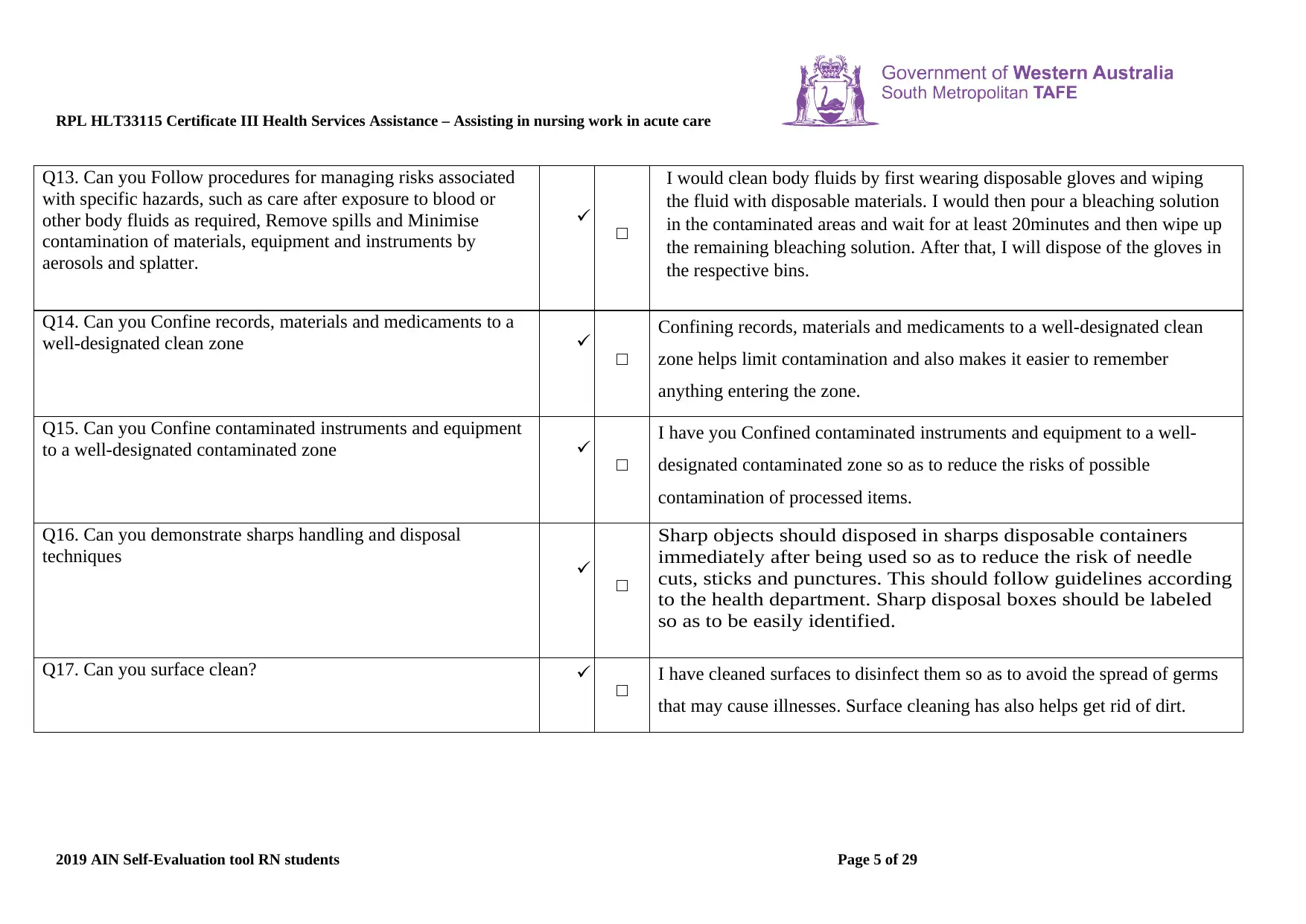
RPL HLT33115 Certificate III Health Services Assistance – Assisting in nursing work in acute care
Q13. Can you Follow procedures for managing risks associated
with specific hazards, such as care after exposure to blood or
other body fluids as required, Remove spills and Minimise
contamination of materials, equipment and instruments by
aerosols and splatter.
□
I would clean body fluids by first wearing disposable gloves and wiping
the fluid with disposable materials. I would then pour a bleaching solution
in the contaminated areas and wait for at least 20minutes and then wipe up
the remaining bleaching solution. After that, I will dispose of the gloves in
the respective bins.
Q14. Can you Confine records, materials and medicaments to a
well-designated clean zone □
Confining records, materials and medicaments to a well-designated clean
zone helps limit contamination and also makes it easier to remember
anything entering the zone.
Q15. Can you Confine contaminated instruments and equipment
to a well-designated contaminated zone □
I have you Confined contaminated instruments and equipment to a well-
designated contaminated zone so as to reduce the risks of possible
contamination of processed items.
Q16. Can you demonstrate sharps handling and disposal
techniques □
Sharp objects should disposed in sharps disposable containers
immediately after being used so as to reduce the risk of needle
cuts, sticks and punctures. This should follow guidelines according
to the health department. Sharp disposal boxes should be labeled
so as to be easily identified.
Q17. Can you surface clean? □ I have cleaned surfaces to disinfect them so as to avoid the spread of germs
that may cause illnesses. Surface cleaning has also helps get rid of dirt.
2019 AIN Self-Evaluation tool RN students Page 5 of 29
Q13. Can you Follow procedures for managing risks associated
with specific hazards, such as care after exposure to blood or
other body fluids as required, Remove spills and Minimise
contamination of materials, equipment and instruments by
aerosols and splatter.
□
I would clean body fluids by first wearing disposable gloves and wiping
the fluid with disposable materials. I would then pour a bleaching solution
in the contaminated areas and wait for at least 20minutes and then wipe up
the remaining bleaching solution. After that, I will dispose of the gloves in
the respective bins.
Q14. Can you Confine records, materials and medicaments to a
well-designated clean zone □
Confining records, materials and medicaments to a well-designated clean
zone helps limit contamination and also makes it easier to remember
anything entering the zone.
Q15. Can you Confine contaminated instruments and equipment
to a well-designated contaminated zone □
I have you Confined contaminated instruments and equipment to a well-
designated contaminated zone so as to reduce the risks of possible
contamination of processed items.
Q16. Can you demonstrate sharps handling and disposal
techniques □
Sharp objects should disposed in sharps disposable containers
immediately after being used so as to reduce the risk of needle
cuts, sticks and punctures. This should follow guidelines according
to the health department. Sharp disposal boxes should be labeled
so as to be easily identified.
Q17. Can you surface clean? □ I have cleaned surfaces to disinfect them so as to avoid the spread of germs
that may cause illnesses. Surface cleaning has also helps get rid of dirt.
2019 AIN Self-Evaluation tool RN students Page 5 of 29
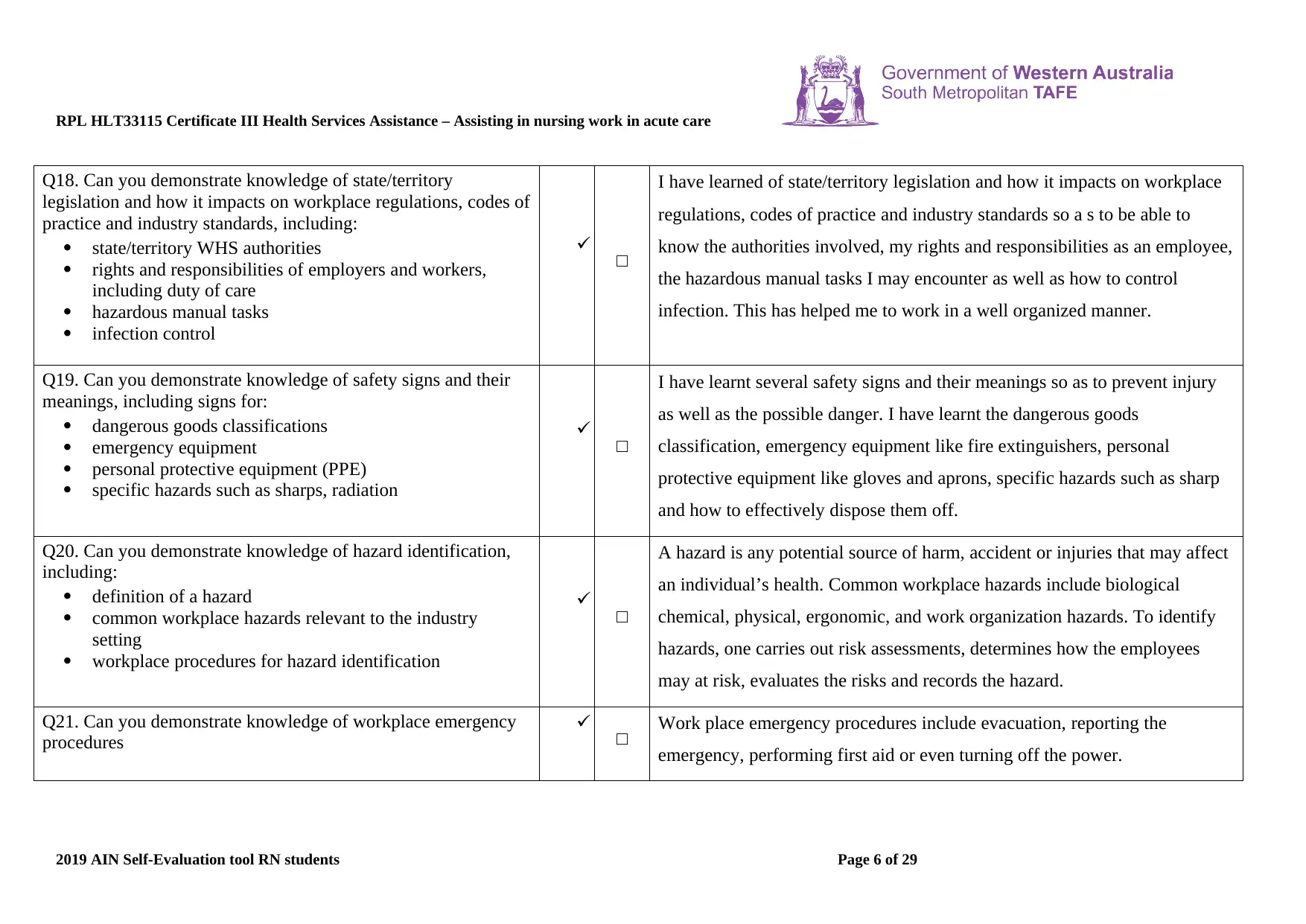
RPL HLT33115 Certificate III Health Services Assistance – Assisting in nursing work in acute care
Q18. Can you demonstrate knowledge of state/territory
legislation and how it impacts on workplace regulations, codes of
practice and industry standards, including:
state/territory WHS authorities
rights and responsibilities of employers and workers,
including duty of care
hazardous manual tasks
infection control
□
I have learned of state/territory legislation and how it impacts on workplace
regulations, codes of practice and industry standards so a s to be able to
know the authorities involved, my rights and responsibilities as an employee,
the hazardous manual tasks I may encounter as well as how to control
infection. This has helped me to work in a well organized manner.
Q19. Can you demonstrate knowledge of safety signs and their
meanings, including signs for:
dangerous goods classifications
emergency equipment
personal protective equipment (PPE)
specific hazards such as sharps, radiation
□
I have learnt several safety signs and their meanings so as to prevent injury
as well as the possible danger. I have learnt the dangerous goods
classification, emergency equipment like fire extinguishers, personal
protective equipment like gloves and aprons, specific hazards such as sharp
and how to effectively dispose them off.
Q20. Can you demonstrate knowledge of hazard identification,
including:
definition of a hazard
common workplace hazards relevant to the industry
setting
workplace procedures for hazard identification
□
A hazard is any potential source of harm, accident or injuries that may affect
an individual’s health. Common workplace hazards include biological
chemical, physical, ergonomic, and work organization hazards. To identify
hazards, one carries out risk assessments, determines how the employees
may at risk, evaluates the risks and records the hazard.
Q21. Can you demonstrate knowledge of workplace emergency
procedures
□ Work place emergency procedures include evacuation, reporting the
emergency, performing first aid or even turning off the power.
2019 AIN Self-Evaluation tool RN students Page 6 of 29
Q18. Can you demonstrate knowledge of state/territory
legislation and how it impacts on workplace regulations, codes of
practice and industry standards, including:
state/territory WHS authorities
rights and responsibilities of employers and workers,
including duty of care
hazardous manual tasks
infection control
□
I have learned of state/territory legislation and how it impacts on workplace
regulations, codes of practice and industry standards so a s to be able to
know the authorities involved, my rights and responsibilities as an employee,
the hazardous manual tasks I may encounter as well as how to control
infection. This has helped me to work in a well organized manner.
Q19. Can you demonstrate knowledge of safety signs and their
meanings, including signs for:
dangerous goods classifications
emergency equipment
personal protective equipment (PPE)
specific hazards such as sharps, radiation
□
I have learnt several safety signs and their meanings so as to prevent injury
as well as the possible danger. I have learnt the dangerous goods
classification, emergency equipment like fire extinguishers, personal
protective equipment like gloves and aprons, specific hazards such as sharp
and how to effectively dispose them off.
Q20. Can you demonstrate knowledge of hazard identification,
including:
definition of a hazard
common workplace hazards relevant to the industry
setting
workplace procedures for hazard identification
□
A hazard is any potential source of harm, accident or injuries that may affect
an individual’s health. Common workplace hazards include biological
chemical, physical, ergonomic, and work organization hazards. To identify
hazards, one carries out risk assessments, determines how the employees
may at risk, evaluates the risks and records the hazard.
Q21. Can you demonstrate knowledge of workplace emergency
procedures
□ Work place emergency procedures include evacuation, reporting the
emergency, performing first aid or even turning off the power.
2019 AIN Self-Evaluation tool RN students Page 6 of 29
⊘ This is a preview!⊘
Do you want full access?
Subscribe today to unlock all pages.

Trusted by 1+ million students worldwide
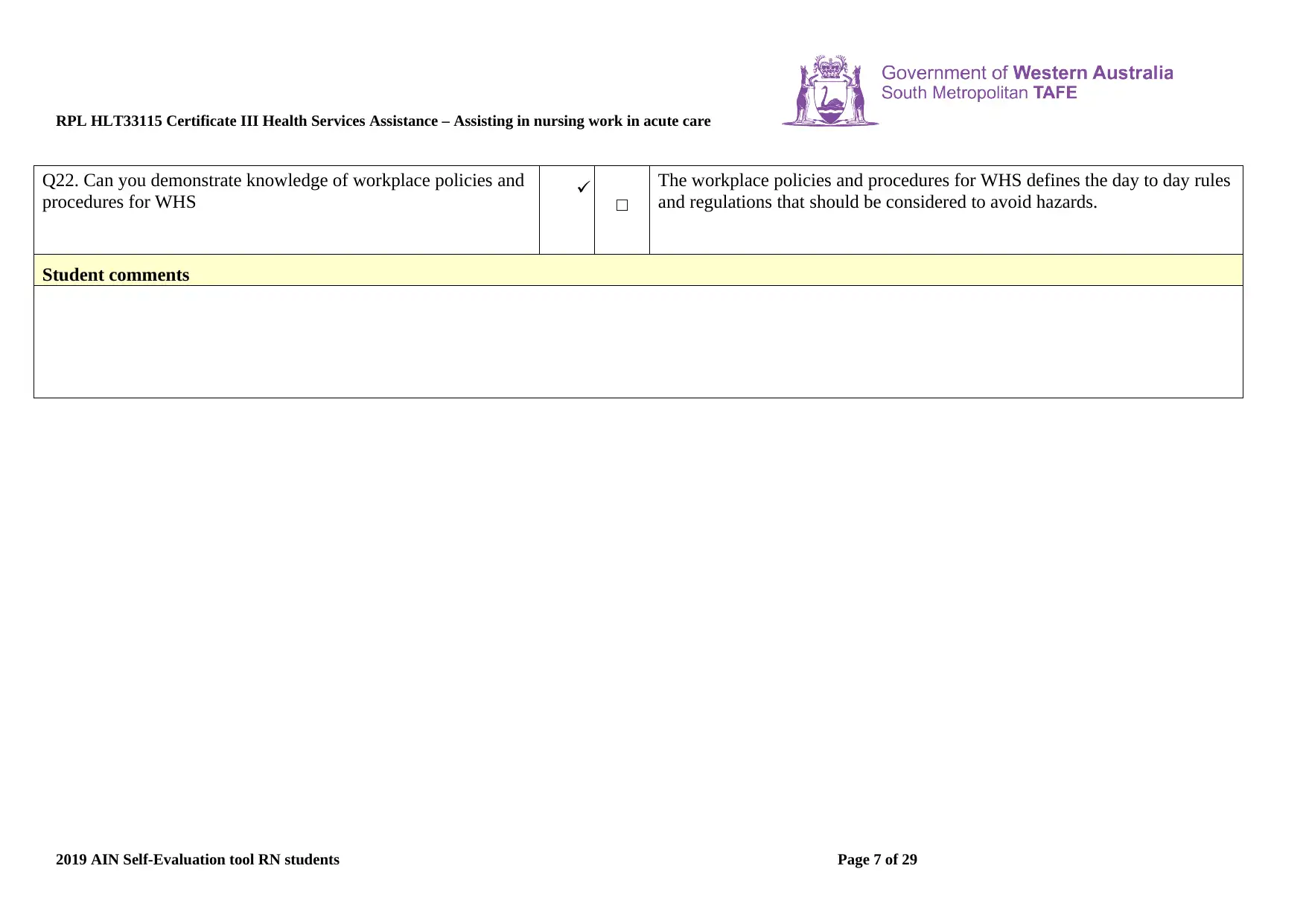
RPL HLT33115 Certificate III Health Services Assistance – Assisting in nursing work in acute care
Q22. Can you demonstrate knowledge of workplace policies and
procedures for WHS □
The workplace policies and procedures for WHS defines the day to day rules
and regulations that should be considered to avoid hazards.
Student comments
2019 AIN Self-Evaluation tool RN students Page 7 of 29
Q22. Can you demonstrate knowledge of workplace policies and
procedures for WHS □
The workplace policies and procedures for WHS defines the day to day rules
and regulations that should be considered to avoid hazards.
Student comments
2019 AIN Self-Evaluation tool RN students Page 7 of 29
Paraphrase This Document
Need a fresh take? Get an instant paraphrase of this document with our AI Paraphraser
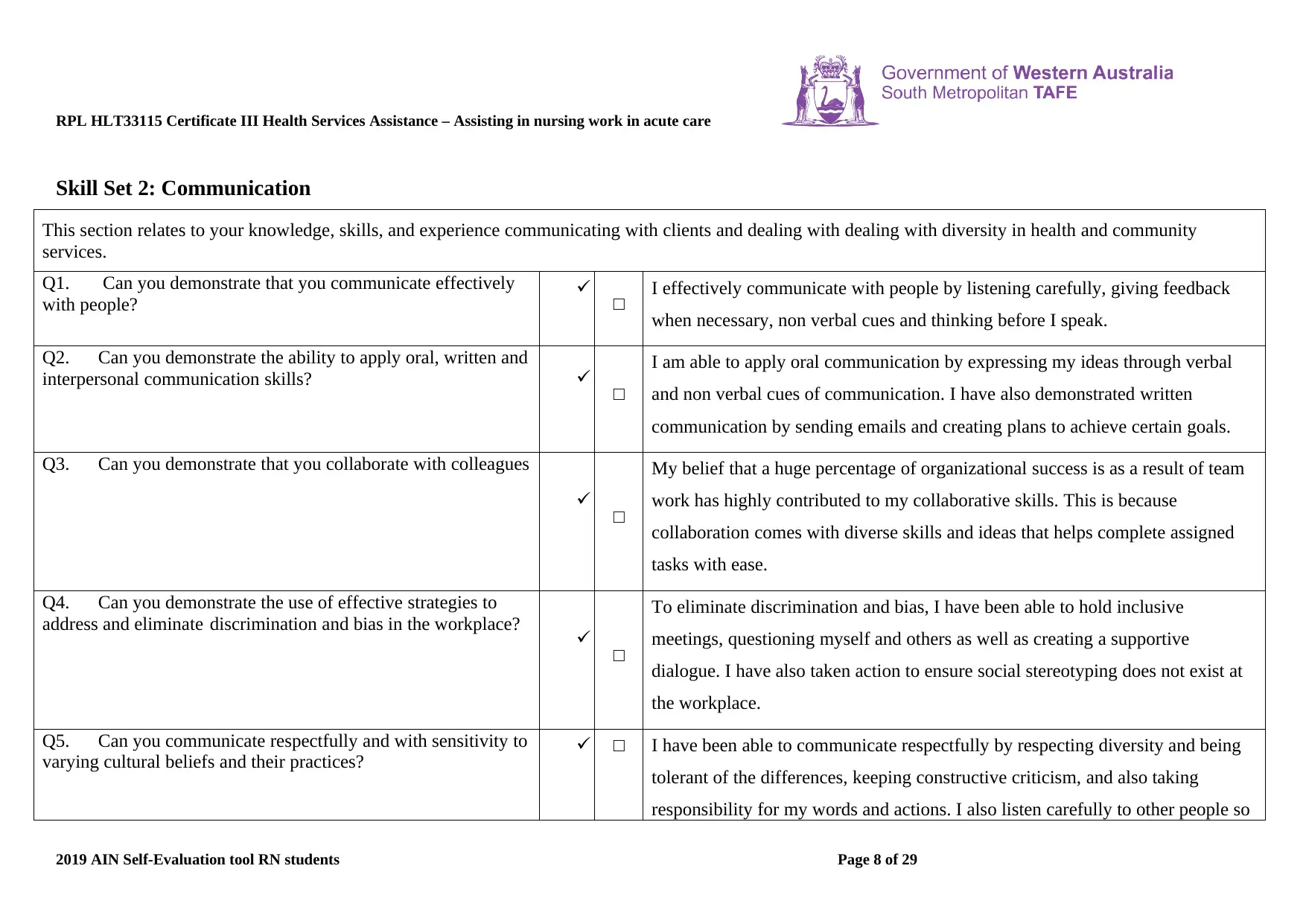
RPL HLT33115 Certificate III Health Services Assistance – Assisting in nursing work in acute care
Skill Set 2: Communication
This section relates to your knowledge, skills, and experience communicating with clients and dealing with dealing with diversity in health and community
services.
Q1. Can you demonstrate that you communicate effectively
with people? □ I effectively communicate with people by listening carefully, giving feedback
when necessary, non verbal cues and thinking before I speak.
Q2. Can you demonstrate the ability to apply oral, written and
interpersonal communication skills? □
I am able to apply oral communication by expressing my ideas through verbal
and non verbal cues of communication. I have also demonstrated written
communication by sending emails and creating plans to achieve certain goals.
Q3. Can you demonstrate that you collaborate with colleagues
□
My belief that a huge percentage of organizational success is as a result of team
work has highly contributed to my collaborative skills. This is because
collaboration comes with diverse skills and ideas that helps complete assigned
tasks with ease.
Q4. Can you demonstrate the use of effective strategies to
address and eliminate discrimination and bias in the workplace? □
To eliminate discrimination and bias, I have been able to hold inclusive
meetings, questioning myself and others as well as creating a supportive
dialogue. I have also taken action to ensure social stereotyping does not exist at
the workplace.
Q5. Can you communicate respectfully and with sensitivity to
varying cultural beliefs and their practices? □ I have been able to communicate respectfully by respecting diversity and being
tolerant of the differences, keeping constructive criticism, and also taking
responsibility for my words and actions. I also listen carefully to other people so
2019 AIN Self-Evaluation tool RN students Page 8 of 29
Skill Set 2: Communication
This section relates to your knowledge, skills, and experience communicating with clients and dealing with dealing with diversity in health and community
services.
Q1. Can you demonstrate that you communicate effectively
with people? □ I effectively communicate with people by listening carefully, giving feedback
when necessary, non verbal cues and thinking before I speak.
Q2. Can you demonstrate the ability to apply oral, written and
interpersonal communication skills? □
I am able to apply oral communication by expressing my ideas through verbal
and non verbal cues of communication. I have also demonstrated written
communication by sending emails and creating plans to achieve certain goals.
Q3. Can you demonstrate that you collaborate with colleagues
□
My belief that a huge percentage of organizational success is as a result of team
work has highly contributed to my collaborative skills. This is because
collaboration comes with diverse skills and ideas that helps complete assigned
tasks with ease.
Q4. Can you demonstrate the use of effective strategies to
address and eliminate discrimination and bias in the workplace? □
To eliminate discrimination and bias, I have been able to hold inclusive
meetings, questioning myself and others as well as creating a supportive
dialogue. I have also taken action to ensure social stereotyping does not exist at
the workplace.
Q5. Can you communicate respectfully and with sensitivity to
varying cultural beliefs and their practices? □ I have been able to communicate respectfully by respecting diversity and being
tolerant of the differences, keeping constructive criticism, and also taking
responsibility for my words and actions. I also listen carefully to other people so
2019 AIN Self-Evaluation tool RN students Page 8 of 29
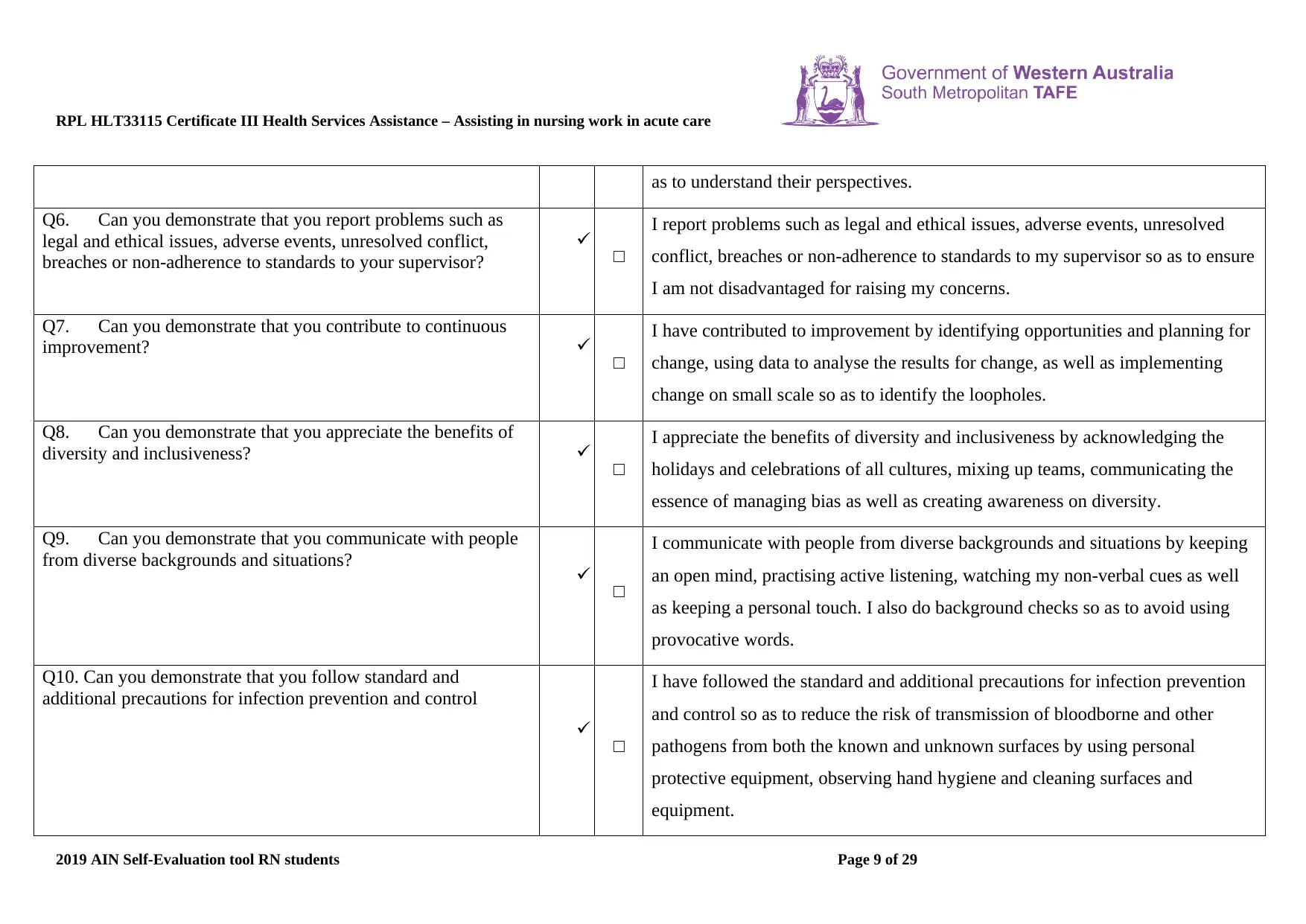
RPL HLT33115 Certificate III Health Services Assistance – Assisting in nursing work in acute care
as to understand their perspectives.
Q6. Can you demonstrate that you report problems such as
legal and ethical issues, adverse events, unresolved conflict,
breaches or non-adherence to standards to your supervisor?
□
I report problems such as legal and ethical issues, adverse events, unresolved
conflict, breaches or non-adherence to standards to my supervisor so as to ensure
I am not disadvantaged for raising my concerns.
Q7. Can you demonstrate that you contribute to continuous
improvement? □
I have contributed to improvement by identifying opportunities and planning for
change, using data to analyse the results for change, as well as implementing
change on small scale so as to identify the loopholes.
Q8. Can you demonstrate that you appreciate the benefits of
diversity and inclusiveness? □
I appreciate the benefits of diversity and inclusiveness by acknowledging the
holidays and celebrations of all cultures, mixing up teams, communicating the
essence of managing bias as well as creating awareness on diversity.
Q9. Can you demonstrate that you communicate with people
from diverse backgrounds and situations? □
I communicate with people from diverse backgrounds and situations by keeping
an open mind, practising active listening, watching my non-verbal cues as well
as keeping a personal touch. I also do background checks so as to avoid using
provocative words.
Q10. Can you demonstrate that you follow standard and
additional precautions for infection prevention and control
□
I have followed the standard and additional precautions for infection prevention
and control so as to reduce the risk of transmission of bloodborne and other
pathogens from both the known and unknown surfaces by using personal
protective equipment, observing hand hygiene and cleaning surfaces and
equipment.
2019 AIN Self-Evaluation tool RN students Page 9 of 29
as to understand their perspectives.
Q6. Can you demonstrate that you report problems such as
legal and ethical issues, adverse events, unresolved conflict,
breaches or non-adherence to standards to your supervisor?
□
I report problems such as legal and ethical issues, adverse events, unresolved
conflict, breaches or non-adherence to standards to my supervisor so as to ensure
I am not disadvantaged for raising my concerns.
Q7. Can you demonstrate that you contribute to continuous
improvement? □
I have contributed to improvement by identifying opportunities and planning for
change, using data to analyse the results for change, as well as implementing
change on small scale so as to identify the loopholes.
Q8. Can you demonstrate that you appreciate the benefits of
diversity and inclusiveness? □
I appreciate the benefits of diversity and inclusiveness by acknowledging the
holidays and celebrations of all cultures, mixing up teams, communicating the
essence of managing bias as well as creating awareness on diversity.
Q9. Can you demonstrate that you communicate with people
from diverse backgrounds and situations? □
I communicate with people from diverse backgrounds and situations by keeping
an open mind, practising active listening, watching my non-verbal cues as well
as keeping a personal touch. I also do background checks so as to avoid using
provocative words.
Q10. Can you demonstrate that you follow standard and
additional precautions for infection prevention and control
□
I have followed the standard and additional precautions for infection prevention
and control so as to reduce the risk of transmission of bloodborne and other
pathogens from both the known and unknown surfaces by using personal
protective equipment, observing hand hygiene and cleaning surfaces and
equipment.
2019 AIN Self-Evaluation tool RN students Page 9 of 29
⊘ This is a preview!⊘
Do you want full access?
Subscribe today to unlock all pages.

Trusted by 1+ million students worldwide
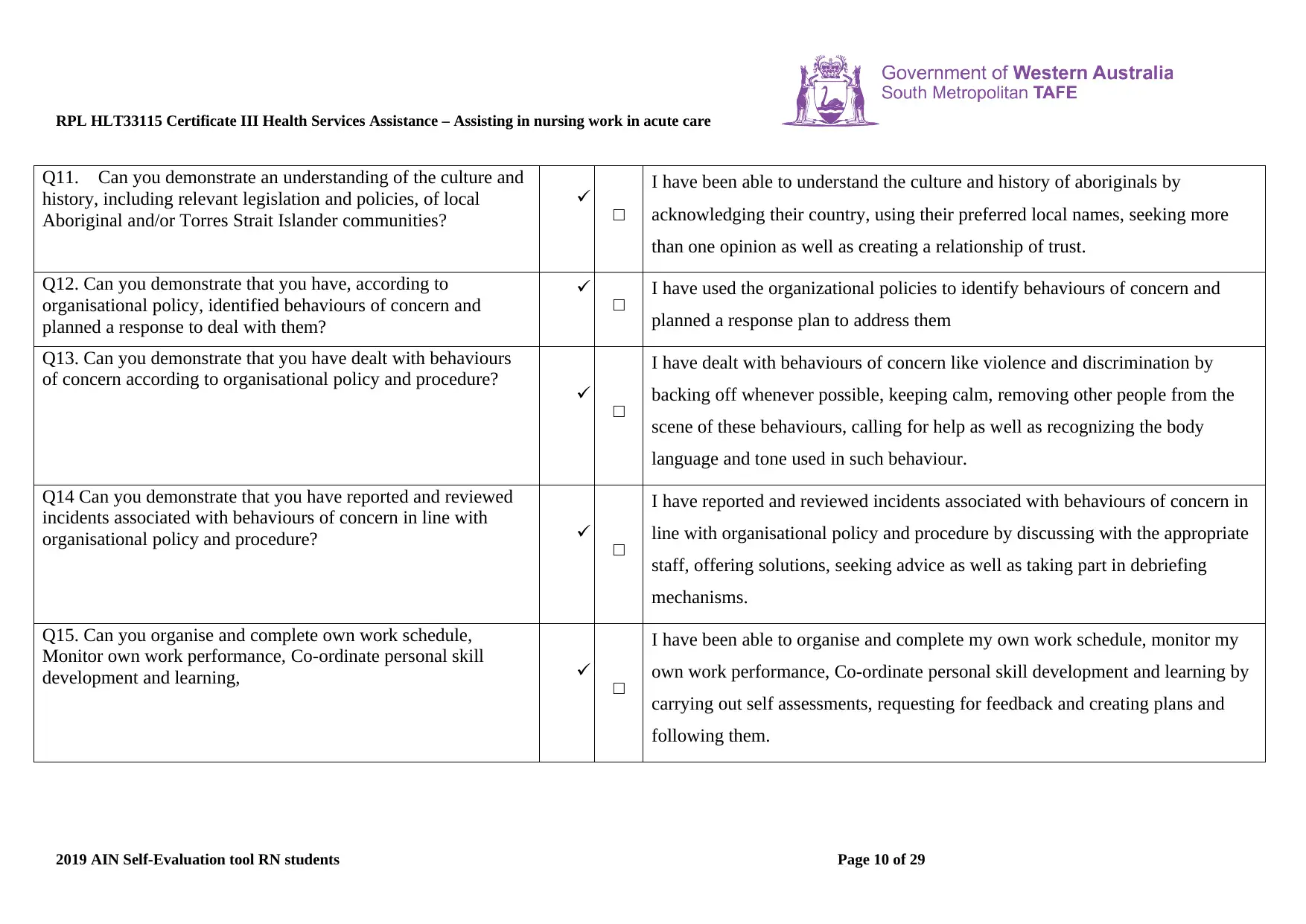
RPL HLT33115 Certificate III Health Services Assistance – Assisting in nursing work in acute care
Q11. Can you demonstrate an understanding of the culture and
history, including relevant legislation and policies, of local
Aboriginal and/or Torres Strait Islander communities?
□
I have been able to understand the culture and history of aboriginals by
acknowledging their country, using their preferred local names, seeking more
than one opinion as well as creating a relationship of trust.
Q12. Can you demonstrate that you have, according to
organisational policy, identified behaviours of concern and
planned a response to deal with them?
□ I have used the organizational policies to identify behaviours of concern and
planned a response plan to address them
Q13. Can you demonstrate that you have dealt with behaviours
of concern according to organisational policy and procedure? □
I have dealt with behaviours of concern like violence and discrimination by
backing off whenever possible, keeping calm, removing other people from the
scene of these behaviours, calling for help as well as recognizing the body
language and tone used in such behaviour.
Q14 Can you demonstrate that you have reported and reviewed
incidents associated with behaviours of concern in line with
organisational policy and procedure? □
I have reported and reviewed incidents associated with behaviours of concern in
line with organisational policy and procedure by discussing with the appropriate
staff, offering solutions, seeking advice as well as taking part in debriefing
mechanisms.
Q15. Can you organise and complete own work schedule,
Monitor own work performance, Co-ordinate personal skill
development and learning, □
I have been able to organise and complete my own work schedule, monitor my
own work performance, Co-ordinate personal skill development and learning by
carrying out self assessments, requesting for feedback and creating plans and
following them.
2019 AIN Self-Evaluation tool RN students Page 10 of 29
Q11. Can you demonstrate an understanding of the culture and
history, including relevant legislation and policies, of local
Aboriginal and/or Torres Strait Islander communities?
□
I have been able to understand the culture and history of aboriginals by
acknowledging their country, using their preferred local names, seeking more
than one opinion as well as creating a relationship of trust.
Q12. Can you demonstrate that you have, according to
organisational policy, identified behaviours of concern and
planned a response to deal with them?
□ I have used the organizational policies to identify behaviours of concern and
planned a response plan to address them
Q13. Can you demonstrate that you have dealt with behaviours
of concern according to organisational policy and procedure? □
I have dealt with behaviours of concern like violence and discrimination by
backing off whenever possible, keeping calm, removing other people from the
scene of these behaviours, calling for help as well as recognizing the body
language and tone used in such behaviour.
Q14 Can you demonstrate that you have reported and reviewed
incidents associated with behaviours of concern in line with
organisational policy and procedure? □
I have reported and reviewed incidents associated with behaviours of concern in
line with organisational policy and procedure by discussing with the appropriate
staff, offering solutions, seeking advice as well as taking part in debriefing
mechanisms.
Q15. Can you organise and complete own work schedule,
Monitor own work performance, Co-ordinate personal skill
development and learning, □
I have been able to organise and complete my own work schedule, monitor my
own work performance, Co-ordinate personal skill development and learning by
carrying out self assessments, requesting for feedback and creating plans and
following them.
2019 AIN Self-Evaluation tool RN students Page 10 of 29
Paraphrase This Document
Need a fresh take? Get an instant paraphrase of this document with our AI Paraphraser
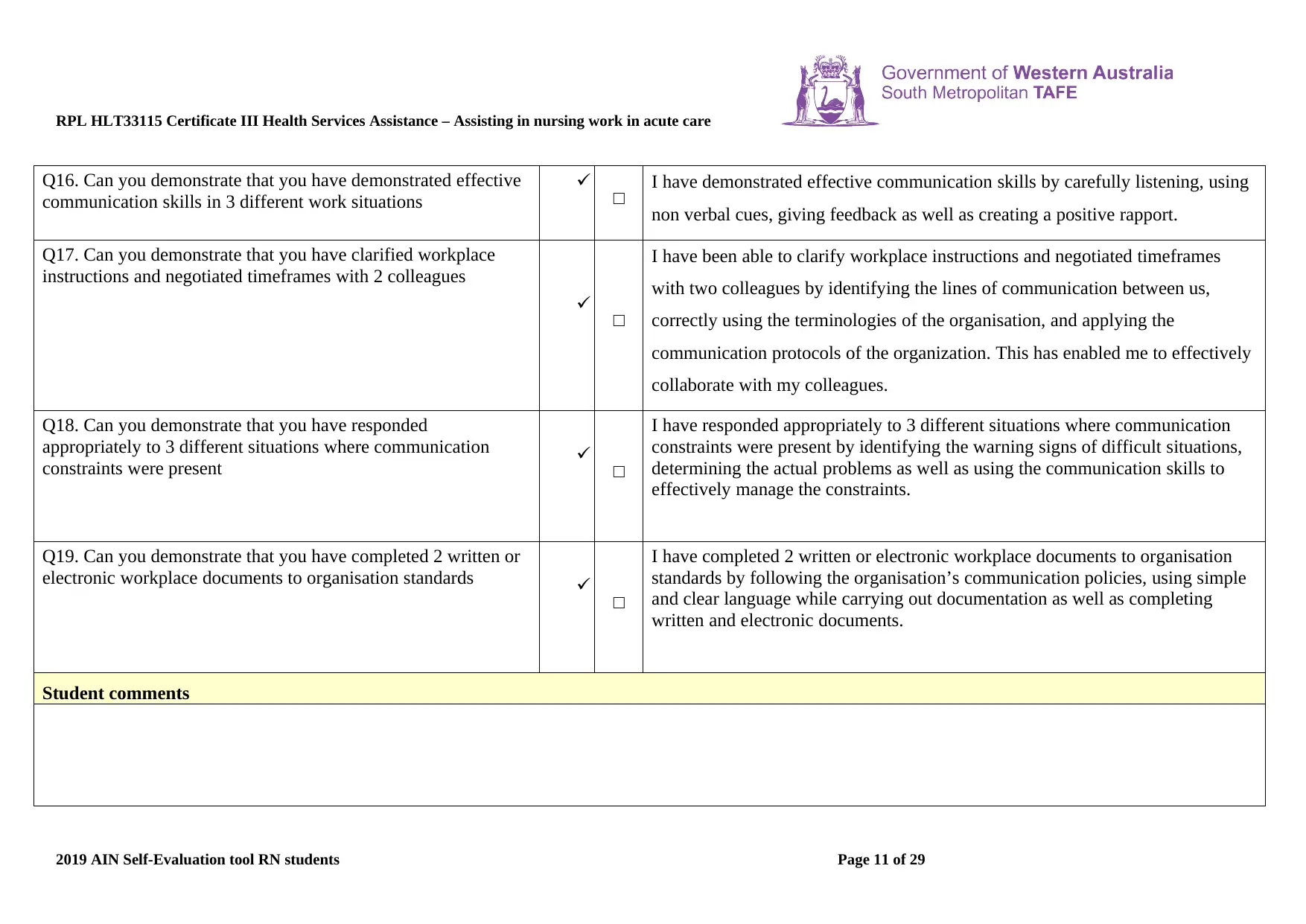
RPL HLT33115 Certificate III Health Services Assistance – Assisting in nursing work in acute care
Q16. Can you demonstrate that you have demonstrated effective
communication skills in 3 different work situations
□ I have demonstrated effective communication skills by carefully listening, using
non verbal cues, giving feedback as well as creating a positive rapport.
Q17. Can you demonstrate that you have clarified workplace
instructions and negotiated timeframes with 2 colleagues
□
I have been able to clarify workplace instructions and negotiated timeframes
with two colleagues by identifying the lines of communication between us,
correctly using the terminologies of the organisation, and applying the
communication protocols of the organization. This has enabled me to effectively
collaborate with my colleagues.
Q18. Can you demonstrate that you have responded
appropriately to 3 different situations where communication
constraints were present □
I have responded appropriately to 3 different situations where communication
constraints were present by identifying the warning signs of difficult situations,
determining the actual problems as well as using the communication skills to
effectively manage the constraints.
Q19. Can you demonstrate that you have completed 2 written or
electronic workplace documents to organisation standards □
I have completed 2 written or electronic workplace documents to organisation
standards by following the organisation’s communication policies, using simple
and clear language while carrying out documentation as well as completing
written and electronic documents.
Student comments
2019 AIN Self-Evaluation tool RN students Page 11 of 29
Q16. Can you demonstrate that you have demonstrated effective
communication skills in 3 different work situations
□ I have demonstrated effective communication skills by carefully listening, using
non verbal cues, giving feedback as well as creating a positive rapport.
Q17. Can you demonstrate that you have clarified workplace
instructions and negotiated timeframes with 2 colleagues
□
I have been able to clarify workplace instructions and negotiated timeframes
with two colleagues by identifying the lines of communication between us,
correctly using the terminologies of the organisation, and applying the
communication protocols of the organization. This has enabled me to effectively
collaborate with my colleagues.
Q18. Can you demonstrate that you have responded
appropriately to 3 different situations where communication
constraints were present □
I have responded appropriately to 3 different situations where communication
constraints were present by identifying the warning signs of difficult situations,
determining the actual problems as well as using the communication skills to
effectively manage the constraints.
Q19. Can you demonstrate that you have completed 2 written or
electronic workplace documents to organisation standards □
I have completed 2 written or electronic workplace documents to organisation
standards by following the organisation’s communication policies, using simple
and clear language while carrying out documentation as well as completing
written and electronic documents.
Student comments
2019 AIN Self-Evaluation tool RN students Page 11 of 29
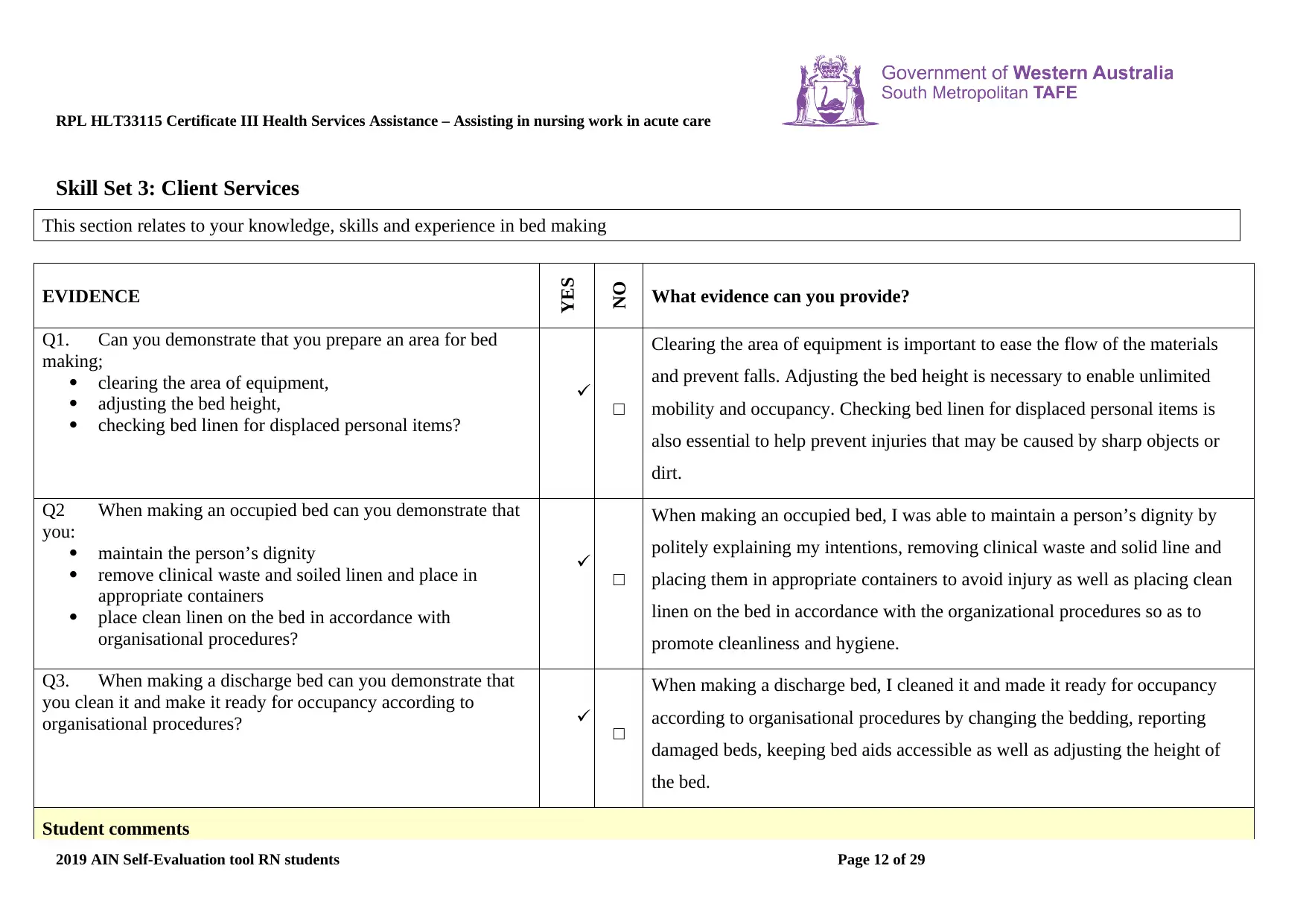
RPL HLT33115 Certificate III Health Services Assistance – Assisting in nursing work in acute care
Skill Set 3: Client Services
This section relates to your knowledge, skills and experience in bed making
EVIDENCE
YES
NO
What evidence can you provide?
Q1. Can you demonstrate that you prepare an area for bed
making;
clearing the area of equipment,
adjusting the bed height,
checking bed linen for displaced personal items?
□
Clearing the area of equipment is important to ease the flow of the materials
and prevent falls. Adjusting the bed height is necessary to enable unlimited
mobility and occupancy. Checking bed linen for displaced personal items is
also essential to help prevent injuries that may be caused by sharp objects or
dirt.
Q2 When making an occupied bed can you demonstrate that
you:
maintain the person’s dignity
remove clinical waste and soiled linen and place in
appropriate containers
place clean linen on the bed in accordance with
organisational procedures?
□
When making an occupied bed, I was able to maintain a person’s dignity by
politely explaining my intentions, removing clinical waste and solid line and
placing them in appropriate containers to avoid injury as well as placing clean
linen on the bed in accordance with the organizational procedures so as to
promote cleanliness and hygiene.
Q3. When making a discharge bed can you demonstrate that
you clean it and make it ready for occupancy according to
organisational procedures? □
When making a discharge bed, I cleaned it and made it ready for occupancy
according to organisational procedures by changing the bedding, reporting
damaged beds, keeping bed aids accessible as well as adjusting the height of
the bed.
Student comments
2019 AIN Self-Evaluation tool RN students Page 12 of 29
Skill Set 3: Client Services
This section relates to your knowledge, skills and experience in bed making
EVIDENCE
YES
NO
What evidence can you provide?
Q1. Can you demonstrate that you prepare an area for bed
making;
clearing the area of equipment,
adjusting the bed height,
checking bed linen for displaced personal items?
□
Clearing the area of equipment is important to ease the flow of the materials
and prevent falls. Adjusting the bed height is necessary to enable unlimited
mobility and occupancy. Checking bed linen for displaced personal items is
also essential to help prevent injuries that may be caused by sharp objects or
dirt.
Q2 When making an occupied bed can you demonstrate that
you:
maintain the person’s dignity
remove clinical waste and soiled linen and place in
appropriate containers
place clean linen on the bed in accordance with
organisational procedures?
□
When making an occupied bed, I was able to maintain a person’s dignity by
politely explaining my intentions, removing clinical waste and solid line and
placing them in appropriate containers to avoid injury as well as placing clean
linen on the bed in accordance with the organizational procedures so as to
promote cleanliness and hygiene.
Q3. When making a discharge bed can you demonstrate that
you clean it and make it ready for occupancy according to
organisational procedures? □
When making a discharge bed, I cleaned it and made it ready for occupancy
according to organisational procedures by changing the bedding, reporting
damaged beds, keeping bed aids accessible as well as adjusting the height of
the bed.
Student comments
2019 AIN Self-Evaluation tool RN students Page 12 of 29
⊘ This is a preview!⊘
Do you want full access?
Subscribe today to unlock all pages.

Trusted by 1+ million students worldwide
1 out of 29
Related Documents
Your All-in-One AI-Powered Toolkit for Academic Success.
+13062052269
info@desklib.com
Available 24*7 on WhatsApp / Email
![[object Object]](/_next/static/media/star-bottom.7253800d.svg)
Unlock your academic potential
Copyright © 2020–2025 A2Z Services. All Rights Reserved. Developed and managed by ZUCOL.





